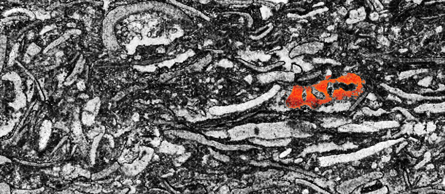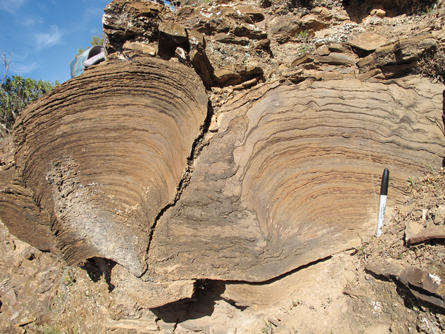

Little asymmetric whatsits from Australia may be the oldest fossils of full-fledged animal bodies yet discovered, beating the previous contenders by tens of millions of years and pushing the evidence for animal life into an earlier geologic time.
The newly unveiled fossils, which resemble sponges, come from rocks between 635 million and 659 million years old, Adam Maloof of Princeton University and his colleagues report online in Nature Geoscience August 17. That timing sandwiches the fossils between two cold spells that iced over most of the planet during a Hollywood-disaster-style geologic period called the Cryogenian.
The proposed animal fossils do “have all the hallmarks” of being something more than just fragments of microbial mats, says biogeochemist Roger Summons of MIT, who was not involved in the study. These layers of single-celled organisms dominated the fossil record for billions of years before the appearance of true multicelled animals.
Simple forms of life, such as bacteria and even algae with cell nuclei, lived during the Cryogenian. Just before the first of the big snowball ice ages, “we start to get some very cool-looking amoebae,” Maloof says. There are indirect signs that fully multicelluar animals probably evolved then too, he says, including chemical traces (SN: 2/28/09, p. 13) from rocks and molecular-clock analyses based on how fast DNA changes. Actual fossils of those animals have been elusive, though.
Work to uncover and analyze the proposed sponges “actually started as something completely different,” Maloof says. He and his colleagues were exploring the Trezona rock formation in southern Australia to learn more about extreme ice ages.
In rock sandwiched between fossilized microbial mats called stromatolites, researchers noticed repeating shapes several millimeters across: anvils, wishbones, rings and belt buckle-like forms that Maloof calls perforated slabs.
Such calcified shapes weren’t distinct enough from the surrounding rocks for X-rays to resolve them. So the researchers developed a new version of software that constructs a 3-D image based on hundreds of scans of a rock surface as it is slowly ground down about 50 micrometers at a time.
What emerged from the Trezona samples were irregular lumps shot through with a network of fine channels that opened to the outside.
“The absence of symmetry and the internal canal system strongly suggests that they are fragments of sponges,” Summons says.
Before settling on sponges, Maloof and his colleagues rejected various notions of what else the fossils could be. Options included the goblet-shaped animal Namacalathus (shaped nothing like it), burrows (too tangled, among other things) and some giant one-celled creature (the fossil had too much internal network and no symmetry).
“The one hypothesis we could not reject was the sponges,” Maloof says.
Molecular-clock evidence certainly does predict that sponges lived during this period, says molecular paleobiologist Kevin Peterson of Dartmouth College in Hanover, N.H. He’s “not convinced” these lumps really are sponges, Peterson says, but “these are intriguing fossils.”
3-D reconstruction of ancient sponge fossils from Science News on Vimeo.
Focusing on a small shape (marked in red) in limestone from south Australia, researchers repeatedly grind away and scan the rock as computer software reconstructs a lumpy spongelike shape with interconnecting internal channels.
Video credit: Situ Studio






